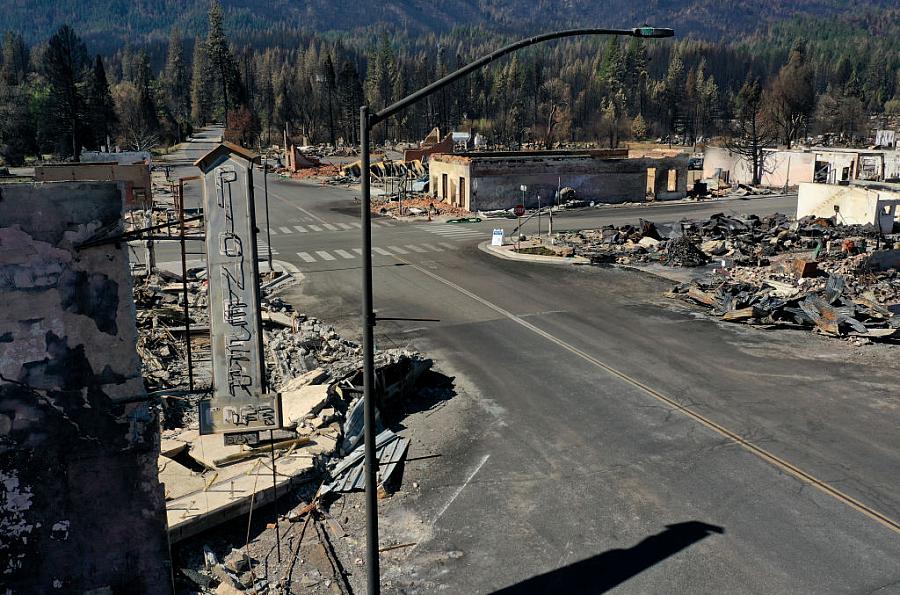California’s most vulnerable communities could be paying the most for power

The remains of homes and businesses in Greenville, California, destroyed by the Dixie Fire in 2021.
Photo by Justin Sullivan/Getty Images
On a July morning in 2021, Pacific Gas & Electric (PG&E) CEO Patti Poppe visited Butte County to make a special announcement. In neighboring Plumas County, the Dixie Fire barreled through thousands of acres of forest, threatening dozens of mountain communities. Days earlier, PG&E told the California Public Utilities Committee (CPUC) that its infrastructure was the likely culprit for starting the fire. It was at least the fourth devastating wildfire the company had sparked in under five years.
Butte County was a symbolic location for the conference because it was the site of the deadliest of those blazes — the 2018 Camp Fire. PG&E had pleaded guilty to 84 counts of manslaughter for its role.
Standing in front of the county’s residents and local reporters, Poppe announced what she called one of the largest infrastructure projects in state history — burying 10,000 miles of utility lines starting in high-risk fire areas like Butte County. The message she wanted to convey was clear, PG&E would commit to doing what it takes to make sure such a tragedy didn’t happen again. Several weeks after that conference, the Dixie Fire destroyed the town of Greenville, another California community reduced to ash.
PG&E and other major California utilities are now undertaking massive projects, promising to improve their infrastructure to reduce the risk of sparking devastating wildfires, but customers are largely footing the bill.
Californians already pay some of the highest rates for power in the nation, and that cost is still rising. The California Public Utility Commission (CPUC) approved a nearly 13% rate hike for PG&E customers, which took effect on Jan. 1. According to a 2023 CPUC report, rate increases in the state are outpacing inflation and are expected to continue to do so. According to the report, “households’ electric bills will become less affordable if household incomes track the inflation rate predicted by the Department of Finance.” The outlook on affordability of electricity was worse in the state’s hotter regions.
At the same time, rising costs of living have pushed many Californians to move from temperate, coastal regions to areas that experience more extreme temperatures. These already vulnerable residents bear the brunt of rising utility costs. In some areas of California, residents reported paying more than $700 dollars a month for their gas and electric bill before the most recent rate hike went into effect. PG&E has several programs to help its most vulnerable customers afford their bills and prevent them from being disconnected due to non-payment. These programs, however, can’t support everyone. As more households struggle to pay rising utility costs, they may be forced to reduce electricity use during extreme temperatures or cut costs in other ways.
In my reporting, supported by a grant from the 2024 California Health Equity Impact Fund, I’ll use data to show where Californians are paying the most for electricity, how much they are paying, and compare it with the average income in those regions. I’ll interview residents about how they’ve adapted to afford rising utility rates and find out how these changes are affecting their health.
California legislators have a deadline of July 1, 2024 to decide on various proposals to make utility rates more affordable for low-income Californians and include a fixed-rate charge based on income. One of those proposals is from utility companies themselves. As part of my reporting, I’ll also examine these proposals to see if the changes could offer the financial relief many Californians are hoping for.
Californians should have the right to have power delivered safely to their homes, without worrying that aging infrastructure could burn down their communities. But power also needs to be affordable so that families don’t have to choose between cooling their homes or paying their rent. As California navigates a changing climate — making both the need for power and its fire risk greater — we need to know how to strike the balance between safety and affordability. This also shouldn’t come at the cost of meeting our renewable energy goals, which offer hope in protecting residents from experiencing more extreme weather. I don’t expect I’ll find that answer in reporting this project. However, I do hope to learn what promising solutions are out there, and what the consequences could be for residents’ safety and health if we fail.

